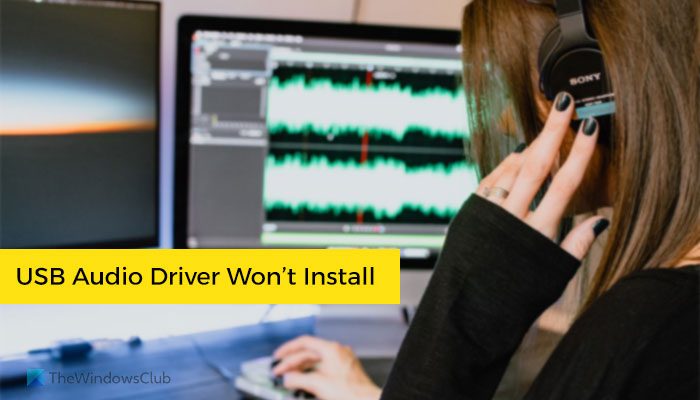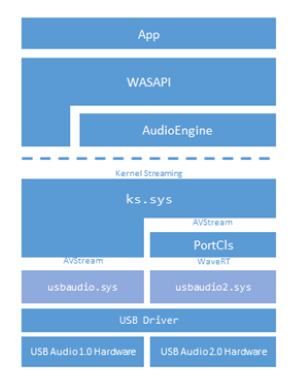In today’s post, we will explore the symptoms, identify the cause, and offer a possible solution to the issue where your Windows doesn’t install specific drivers for USB audio devices on the first connection. Here, we have listed all the possible reasons and solutions for fixing the audio device issues in Windows 11/10 computers.

The symptoms of this issue can be diagnosed as follows. When you connect a USB audio device to a Windows 11/10 computer for the first time, the operating system detects the device but loads the standard USB audio 2.0 driver (usbaudio2.sys) instead of the specific device driver.
In Windows 11/10, now, a USB Audio 2.0 driver is shipped. It is designed to support the USB Audio 2.0 device class. The driver is a WaveRT audio port class Miniport. USBAudio.Sys fits within the wider architecture of Windows USB Audio as shown.

USB audio drivers won’t install on Windows computer
This issue occurs because the USB audio 2.0 driver (usbaudio2.sys) isn’t classified as a generic driver in Windows 11/10. Therefore, the system assumes that a compatible, nongeneric driver is installed for the device even though the driver is actually generic.
This issue also causes Windows to postpone the search for other compatible drivers through Windows Update, which typically occurs immediately after you install a new device.
To fix this issue, Microsoft recommends using one of the following methods:
- Make sure your Windows computer has the latest cumulative update installed.
- If the device-specific driver is distributed through Windows Update, you can manually update the driver by using Device Manager.
- If the device is not yet connected, first install the device-specific driver, such as by using the appropriate installer. After the device-specific driver is installed, Windows 11/10 will select that driver instead of the standard USB audio 2.0 driver when you first connect the device.
- If the driver isn’t distributed through Windows Update, you can manually reinstall the driver. To do this, follow these steps:
-
- Install the device-specific driver (see Method 2).
- Open Device Manager.
- Right-click (or tap and hold) the name of the device, and then select Uninstall.
- Restart the computer.
When it restarts, Windows will try to reinstall the device by using the device-specific driver.
I hope this helps!
Read: Front Audio Jack not working in Windows
How do I reinstall USB audio drivers?
To reinstall USB audio drivers in Windows 11/10, open the Device Manager, expand the Audio inputs and outputs, and right-click on the audio device. Select the Uninstall device option and click on the Uninstall button. Then, download the audio driver from the official website of your audio device manufacturer and double-click on the file to start the installation.
Why is my computer not detecting USB audio?
As there could be so many reasons, here are a few:
- Your USB port has some problems. In that case, switch to another USB port.
- Your audio device is outdated and the driver is not supported in the latest version of Windows. In that case, you can try finding a new version of the driver or changing the audio device.
- At times, background processes or even another audio device can prevent you from using the new USB audio device. In such moments, you need to disable other audio devices.
Related read: Troubleshoot & fix Device Driver Problems.
Leave a Reply